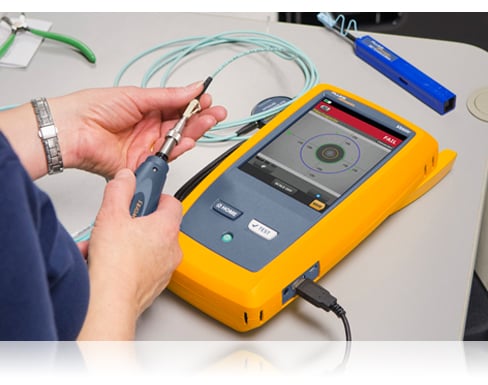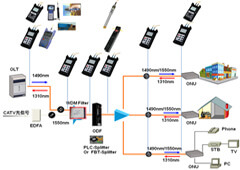How fibre testing equipment is critical for ensuring accuracy
Exploring the Influence of Robotic Vision on Modern Manufacturing Techniques and Quality Control
Robotic vision modern technology is changing the landscape of modern-day production and quality control. By incorporating sophisticated imaging systems and expert system, makers can attain unprecedented degrees of accuracy and efficiency. This change not just optimizes production processes yet likewise addresses critical obstacles in preserving item standards. As sectors increasingly depend on these developments, the implications for future manufacturing methods continue to be to be completely explored. What will this indicate for the competitive dynamics of the marketplace?
Comprehending Robotic Vision Modern Technology
Robotic vision technology acts as the foundation of automation in modern production. It includes using cams, sensors, and man-made knowledge to allow robots to translate and react to aesthetic info from their atmosphere. This modern technology allows robots to identify, find, and examine things, making them efficient in performing intricate tasks such as setting up, evaluation, and product handling with precision. The integration of artificial intelligence algorithms additionally boosts the ability of robotic vision systems, allowing them to adapt to varying problems and enhance gradually. By processing photos and data in real-time, robotic vision systems can help with faster decision-making and lower errors in manufacturing procedures (optical fibre diameter analyser). This technology not only boosts operational effectiveness yet also assures that top quality standards are satisfied constantly. As the manufacturing landscape proceeds to develop, recognizing the intricacies of robot vision innovation comes to be necessary for leveraging its prospective completely
Benefits of Robotic Vision in Manufacturing
Robotic vision modern technology supplies substantial advantages in manufacturing by enhancing accuracy and precision in tasks such as quality control and setting up. This increased degree of information warranties that products fulfill strict criteria, decreasing waste and rework. Additionally, the combination of robotic vision can cause raised manufacturing effectiveness, allowing suppliers to optimize their processes and attain higher output prices.
Enhanced Precision and Accuracy
In modern-day manufacturing, improved precision and accuracy are critical for maximizing production processes and ensuring item top quality. Robotic vision systems make it possible for equipments to carry out complex jobs with exceptional consistency. These systems make use of innovative imaging innovations to spot minute details and variations in materials, parts, and finished items. By analyzing aesthetic information in real-time, robotic vision considerably lowers human mistake, bring about fewer flaws and better standards. Additionally, boosted precision in measurements and positioning facilitates better placement in assembly procedures, which is essential for complex layouts. Ultimately, the assimilation of robotic vision not only reinforces the integrity of producing outcomes but additionally promotes self-confidence among consumers pertaining to item honesty and performance. This accuracy is crucial in industries where high quality is critical.
Enhanced Production Efficiency

Suppliers are increasingly transforming to vision systems to enhance manufacturing efficiency across numerous processes. These advanced systems make it possible for real-time assessment and tracking, substantially minimizing downtime brought on by mistakes or problems. By integrating robotic vision, companies can automate quality assurance, permitting faster identification of concerns and decreasing the demand for human treatment. This results in structured process, as robots can rapidly adjust to adjustments in production demands without sacrificing accuracy. Moreover, vision systems assist in better inventory administration by properly tracking components and items, making certain excellent resource utilization. Ultimately, the fostering of robotic vision not just enhances effectiveness yet also contributes to higher output rates, lowered operational costs, and enhanced overall efficiency in the manufacturing industry.
Enhancing High Quality Control Processes
Robotic vision technology considerably improves quality assurance procedures in manufacturing by using accuracy examination strategies. These sophisticated systems help with real-time problem discovery, making certain that products satisfy rigorous quality requirements. Therefore, manufacturers can lessen waste and boost total effectiveness.
Accuracy Inspection Techniques
Precision evaluation techniques have actually reinvented quality assurance processes in manufacturing, allowing the detection of min flaws that standard methods could forget. These strategies utilize advanced imaging technologies, such as high-resolution cameras and laser scanning, to attain unequaled accuracy. By making use of robot vision systems, producers can automate evaluation tasks, guaranteeing constant efficiency and minimizing human error. The combination of device understanding formulas additionally enhances these systems, permitting them to adjust and enhance over time. Additionally, precision examination helps with the identification of refined variations in item dimensions and surface finishes, which can greatly affect overall item high quality. As a result, suppliers can execute rehabilitative actions much more quickly, inevitably causing reduced waste and improved client complete satisfaction.
Real-Time Flaw Discovery
Using sophisticated imaging modern technologies, real-time defect detection transforms quality assurance procedures in manufacturing. By integrating high-resolution cameras and sophisticated algorithms, producers can swiftly recognize anomalies throughout manufacturing. This innovation helps with instant rehabilitative actions, decreasing waste and boosting overall efficiency. Real-time systems examine products as they move along the production line, ensuring that problems are discovered and dealt with Learn More without postponing manufacturing schedules. On top of that, the execution of machine understanding enhances the accuracy of these systems, enabling them to adjust to new issue patterns with time. Consequently, manufacturers benefit from enhanced item top quality and lowered operational costs. Ultimately, real-time defect detection not only enhances procedures however likewise cultivates a culture of continual enhancement in contemporary production environments.
Real-Time Information Analysis and Choice Making
In the vibrant landscape of manufacturing, real-time data evaluation equips systems to make swift, informed decisions. By leveraging sophisticated robotic vision modern technologies, manufacturers can collect and refine large amounts of data instantaneously. These systems analyze aesthetic inputs to keep an eye on manufacturing processes, making sure that any kind of discrepancies from top quality criteria are identified and addressed without delay. Producers can optimize procedures by reapportioning resources and readjusting workflows based on real-time understandings.
The combination of data analytics enables for anticipating maintenance, where potential equipment failings are expected before they interfere with production. This aggressive strategy reduces downtime and improves total effectiveness. robotic vision. The capacity to make data-driven choices in genuine time significantly decreases waste and enhances item top quality, enabling suppliers to react to market needs swiftly. Because of this, real-time information evaluation not just enhances manufacturing however likewise promotes a culture of continual enhancement in modern-day manufacturing atmospheres
Obstacles in Applying Robotic Vision Systems
Carrying out robot vision systems in manufacturing presents a variety of difficulties that can prevent their efficiency. One significant challenge is the intricacy of integrating these systems with existing machinery and workflows. Manufacturers usually deal with compatibility issues with heritage tools, causing raised prices and downtime. Furthermore, the irregularity in product shapes, sizes, and materials can make complex the calibration of vision systems, requiring comprehensive training and fine-tuning.
One more challenge depends on processing big volumes of aesthetic data in genuine time. High-performance computer sources are essential, which might call for further investment in facilities. There is a lack of competent employees capable of managing and keeping these sophisticated systems, leading to prospective functional ineffectiveness. Making certain the integrity and precision of robotic vision systems under differing environmental conditions postures a continual obstacle. Resolving these problems is important for making the most of the possible advantages of robotic vision in production.
Future Trends in Robotic Vision for Production
As developments in expert system and machine understanding remain to progress, the future of robotic vision in production shows navigate to this website up significantly promising. Arising trends show a change in the direction of much more innovative imaging technologies, such as 3D vision systems and hyperspectral imaging, which will boost accuracy in top quality control procedures. Combination with the Internet of Points (IoT) will enable real-time data analysis, allowing robotic systems to adapt promptly to modifications in the production environment. Moreover, the development of joint robots (cobots) equipped with innovative vision capabilities is expected to facilitate smooth human-robot interactions, boosting effectiveness and security on the manufacturing facility flooring. Additionally, the consolidation of side computing will empower robotic vision systems to refine information locally, minimizing latency and allowing faster decision-making. These technologies will not only streamline manufacturing procedures yet additionally significantly enhance product top quality, placing robotic vision as a cornerstone of future industrial operations.
Regularly Asked Questions
Exactly How Much Does Robotic Vision Technology Commonly Price?
Robotic vision innovation normally costs in between $10,000 and $100,000, depending upon the complexity and specs. Variables affecting rate consist of sensing unit top quality, software capacities, and integration requirements, making it vital to assess details job demands.
What Industries Are Most Influenced by Robotic Vision Advancements?
Robotic vision innovations significantly effect markets such as manufacturing, automobile, electronics, and food processing - robotic vision. These sectors benefit from improved automation, enhanced top quality control, and enhanced performance, resulting in structured operations and reduced labor expenses
Can Robotic Vision Equipments Be Integrated With Existing Machinery?
Robotic vision systems can without a doubt be integrated with existing equipment. This integration improves functional efficiency, enabling producers to take advantage of progressed technologies without the requirement for full overhauls, thereby optimizing manufacturing procedures and keeping quality requirements.

What Skills Are Required to Operate Robotic Vision Equipments?
Running robot vision systems requires efficiency in programs, an understanding of artificial intelligence, understanding of image handling strategies, and the capacity to visit this website repair software and hardware concerns, making certain smooth combination and optimal performance within making settings.
Exist Any Safety Worry About Robotic Vision in Manufacturing?
